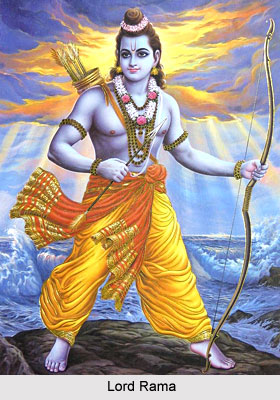 Chaturbhuja Rama swami Temple is one of the three significant temples dedicated to Lord Rama. On the lush outskirts of the tiny village of Ponpadirkudam is stationed the small temple for Chaturbhuja Ramasvami. As the legendary stories depicts, the temple is several hundred years old. The sanctum-sanctorum (garbha-griha) or the principal chamber of this shrine, which faces east, houses the stone images of Rama, Lakshmana, Sita and Hanuman. The principal deity here is Lord Rama, who is seated in the altar with his consort Sita. The principal attraction about this temple is the icon of Lord Rama. The icon of Rama here is particularly unique as he has four hands. Due to this posture he is called Chaturbhuja. The temple is also named after the name of the deity. In His upper left hand He holds the sankha (conch) and in the upper right hand, the chakra (discus). The lower right hand is in abhaya hasta, affording protection to the devotee while the left hand is in varada or boon-giving pose. This exquisite image of Rama with a benevolent smile, seated in ardha-padmasana with His bent left leg resting on the seat and right leg placed in front is truly fascinating.
Chaturbhuja Rama swami Temple is one of the three significant temples dedicated to Lord Rama. On the lush outskirts of the tiny village of Ponpadirkudam is stationed the small temple for Chaturbhuja Ramasvami. As the legendary stories depicts, the temple is several hundred years old. The sanctum-sanctorum (garbha-griha) or the principal chamber of this shrine, which faces east, houses the stone images of Rama, Lakshmana, Sita and Hanuman. The principal deity here is Lord Rama, who is seated in the altar with his consort Sita. The principal attraction about this temple is the icon of Lord Rama. The icon of Rama here is particularly unique as he has four hands. Due to this posture he is called Chaturbhuja. The temple is also named after the name of the deity. In His upper left hand He holds the sankha (conch) and in the upper right hand, the chakra (discus). The lower right hand is in abhaya hasta, affording protection to the devotee while the left hand is in varada or boon-giving pose. This exquisite image of Rama with a benevolent smile, seated in ardha-padmasana with His bent left leg resting on the seat and right leg placed in front is truly fascinating.
Chaturbhuja Rama icons, housed in this temple are a rarity. Since Rama incarnated as a human being and is seen in most temples in a standing posture with two hands holding the bow and arrow, people show less veneration in comparison to Lord Jagannatha and Vishnu. The most famous image of a four-armed Rama is enshrined in the temple at Bhadrachalam in Andhra Pradesh. In the temple at Ponpadirkudam, Sita, holding a lotus in Her left hand and Her right hand resting on Her lap is seen seated on the same pedestal as Rama. This posture of Lord Rama with Devi Sita is indicative of the coronation (pattabhisheka) scene. Lakshmana stands to Rama`s left with His hands folded in anjali pose. He is two-armed with His bow resting on His hand and arrows placed in the casing hanging from His shoulder. Apart from this, another unique feature of this temple is that Hanuman is not found kneeling by the side of the deities as seen in most shrines. This is one of the captivating scenes found in the Chaturbhuja Rama temple. Here the ardent follower of Lord Rama, Hanuman is found standing with his face turning to the images, by the side of the doorway to the sanctum in a respectful attitude.
The bronze image of utsava-murti of a four-armed Rama in a standing posture in this temple is also charming. His two upper arms hold the sankha and chakra while the lower left hand holds the curved bow and right hand the arrow. Even the minute details of this exquisite image like the sharp tips of His fingernails are very clearly visible. The utsava-murti of Sita stands to Rama`s right with Anjaneya next to Her, while to His left is Lakshmana. Thus the images of the Chaturbhuja Rama Temple provide an additional splendor to the historical temple.
There are also metal images of Navaneeta Krishna and Sudarsana (Chakrattazhvar), which are placed and worshipped along with Lord Rama. In the passage in front of the main sanctum a stone image of Lakshmi Narayana is enshrined. It is believed to be the original deity of this shrine, before the image of Lord Rama was consecrated here. A number of legendary stories are associated with Chaturbhuja Rama temple. The legend connected with this temple narrates that a sage named Devaraja Muni was directed by Lord Rama in his dream to bring His icon, which was elsewhere, and to install it here. There are also stone and bronze images of Nammazhvar, Tirumangai Azhvar and the Srivaishnava preceptors, Ramanuja and Vedanta Desika. They are also venerated with equal status like lord Rama.
The Vimana above the main sanctum of Chaturbhuja temple is called Pushpaka Vimana. The tank is named as Devaraja Pushkarini. A myth is associated with the tank named Devaraja pushkarini. The tank is named after Devaraja Muni who performed strong penance on its banks in order to get cured of leprosy after bathing in it. By the side of the main entrance way to this temple is erected the Pavitrotsava Mandapa where the deities from the main shrine are kept for three days during the Pavitrotsava festival in the month of Purattasi (September-October). The other important festivals observed in this temple are Rama Navami in the month of Chittirai (April-May) and Parivettai festival in the month of Thai (January-February). The rituals in this shrine are conducted according to the rules of Vaikhanasa Agama. The festivals are indeed observed with enormous pomp and grandeur and during the time there gathered a chunk of people in the temple precincts.











